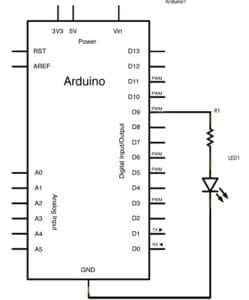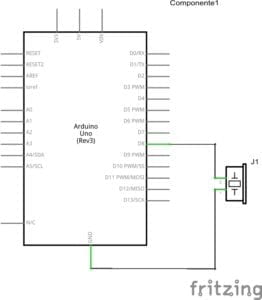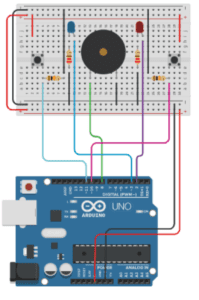For this recitation we built 3 circuits, this time using an Arduino Uno running a program to control them. The first circuit was an LED that would fade on and off, the second one was a buzzer that played a tune, and the last one was a 2 player game in which each player would have to repeatedly press a button inside a certain amount of time, winning by being the player who pressed it the most times. For the first two circuits, we used an example code that could be found in the IDE, and for the last circuit we used the code provided by the user who posted the circuit on Tinkercad.
First Circuit: Fade
We connected the Arduino to an LED, putting a 220 Ohm resistor in between these two. The LED was connected to the Arduino’s digital pin 9 on one side, and ground on the other. We then ran the “fade” example, and it worked, the LED would fade on and off repeatedly.

Second Circuit: Buzzer tune
The Arduino was connected to the buzzer directly, without using a resistor, from digital pin 8, and the buzzer was then connected to ground. We then ran the ToneMelody example, which also worked, and we could hear the buzzer play a programmed melody.

Third Circuit: Game
This circuit was basically five different circuits connected to the same Arduino: 2 buttons, 2 LEDs and a buzzer. The LED’s were connected each to a digital pin and ground, passing through a 220 Ohm resistor. The buttons were also connected to a digital pin and ground, but the circuit went through a 10k Ohm resistor. The buzzer was, too, connected to a digital pin and ground, but did not use resistors. We used the code posted along with the circuit, but couldn’t use the arcade buttons we soldered in the first recitation, since they didn’t work and we couldn’t figure out how to make them work, so we resorted to use normal “4-legged” buttons, which worked to perfection after rearranging the cables a bit so that there was space to press them.

Questions:
- Every time I use technology, it is just me making an input into my device to get an output. When I talk on the phone, I talk into the phone’s microphone (input), the sound I sent to the microphone is processed and converted into waves that are sent to an antenna that relays them to whoever I’m talking with, they listen and answer, and their answer comes out through the speaker on my phone (output). The same thing happens when I browse something on the internet, both on my phone and the computer, I type words by pressing letters on a keyboard (input), I see the letters in the screen that correspond to my input (output), then I press ‘enter’ (input), and the browser loads a page with potential answers to my question (output). Every interaction I have with technology is me making an input in order to receive an output in the shape of information. Therefore, if I were to define interaction between a human and a device, I would define it as a human input-device output process, in which a devices’s output can lead to a human’s input, but the human input will always come first (we are always those who turn on the device, open the laptop, open the program, etc.).
- If I had 100000 LEDs, I would make a screen that I would put in the back of a lecture hall so that it can display the lecturer’s script and/or questions the students may have for the lecturer (it would be connected to wifi) so as to make the lecturer’s speech more time-efficient and cut time lost calling for questions.